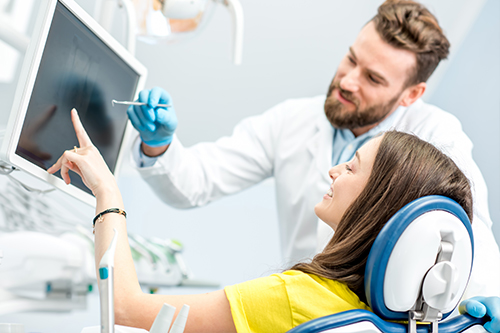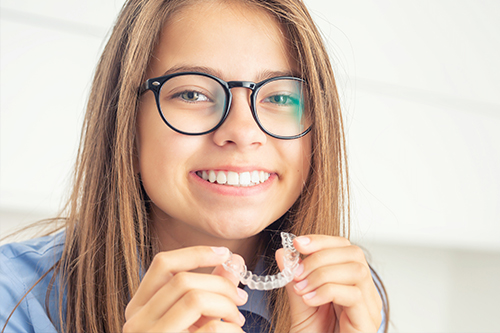
Clear, discreet, and highly adaptable, Invisalign® uses a series of custom-made, removable aligners to move teeth gently and predictably. It’s a modern approach to orthodontic care that lets people pursue straighter teeth with minimal interruption to their everyday lives.
Invisalign® treatment begins with a comprehensive digital scan of your mouth. These scans capture the precise position of each tooth, allowing clinicians to create a phased plan that anticipates how teeth will shift over time. Rather than relying on a single adjustment, the system uses a sequence of aligners that apply subtle, controlled forces to guide movement.
Each aligner is worn for a prescribed period—typically one to two weeks—before advancing to the next in the series. Because the changes are incremental, the treatment feels calmer and more manageable than many traditional approaches. The computer model predicts the trajectory of movement, which helps clinicians evaluate progress and make adjustments when necessary.
Because the aligners are removable, patients maintain their regular oral hygiene routines without the obstacles posed by fixed appliances. That removability also preserves dietary freedom: simple, temporary removal for meals reduces concerns about food restrictions while treatment is underway.
Invisalign® is effective for a wide range of alignment concerns, from mild crowding and spacing to certain bite issues. Many cases that once required braces can now be treated with clear aligners, provided there is a careful assessment and treatment plan developed by an experienced provider. The deciding factors include the complexity of tooth movements required and the patient’s commitment to wearing the aligners as instructed.
Not every situation is identical, and some complex skeletal or jaw-related problems may require additional orthodontic or surgical approaches. That said, for many adults and teens, clear aligners offer a predictable path to improved alignment when paired with routine monitoring and, if needed, auxiliary attachments or refinements.
Choosing the right approach starts with a clinical evaluation and a conversation about goals. A precise diagnosis helps set realistic expectations and ensures that the chosen method will meet both functional and aesthetic objectives.
At Addison Dental Studio, we prioritize a tailored treatment plan that reflects each patient’s anatomy and lifestyle. From the initial consultation through the finishing touches, our goal is to provide care that feels coordinated and transparent. We use digital tools to visualize outcomes so patients can see a treatment roadmap before moving forward.
During treatment, scheduled check-ins allow the clinician to monitor progress, make mid-course corrections if needed, and provide guidance on wear time and aligner care. This ongoing interaction keeps the plan on track and helps patients stay informed about how their smile is changing.
We also emphasize practical guidance—how to care for aligners, maintain oral health, and transition into retention when active alignment is complete. This comprehensive support helps patients protect their investment in a new, healthier smile.
Modern aligner therapy relies on advanced imaging, precision fabrication, and data-driven protocols. Digital intraoral scans replace messy impressions with accurate 3-D models that improve fit and predictability. These digital models feed into manufacturing systems that produce aligners to exacting tolerances so each tray performs as intended.
Software-driven treatment planning allows clinicians to map tooth movement in small, controlled increments, choosing when and where to direct force. Attachments—small, tooth-colored shapes bonded to teeth—can enhance aligner grip for rotations or vertical movements, expanding the range of predictable corrections.
Ongoing improvements in materials and planning algorithms continue to refine comfort and effectiveness, making aligner therapy a progressively more capable option for many alignment needs.
Keeping aligners clean and wearing them according to the prescribed daily schedule are the two most important factors in achieving the expected outcome. Simple rinsing, gentle brushing with a soft brush, and using manufacturer-approved cleaning solutions will help prevent discoloration and odor while preserving clarity.
Consistent wear—typically around 20–22 hours per day—is essential. Skipping hours or frequently removing trays for extended periods slows progress and can alter planned tooth movement. When meals are finished, patients should return aligners promptly to maintain momentum.
After active treatment, wearing retainers as instructed preserves the new tooth positions. Retention is a lifelong consideration; periodic monitoring helps ensure that the improvements remain stable over time.
Although clear aligners have simplified many aspects of orthodontic care, professional oversight remains central to a successful outcome. A clinician evaluates the health of the teeth and gums, reviews radiographic information when appropriate, and designs a plan that balances esthetics and function. Careful monitoring reduces the chance of unintended movement and helps address any concerns promptly.
Refinements and mid-course adjustments are part of many treatment journeys; being open to those options helps ensure the final outcome meets expectations. The clinician’s experience in sequencing movements and troubleshooting challenges is what separates predictable results from uncertain ones.
When treatment is thoughtfully planned and closely supervised, patients are more likely to finish with a stable, comfortable, and attractive smile.
Align Technology has refined aligner systems through extensive clinical data and continuous innovation. That foundation of research allows clinicians to rely on predictable workflows, process controls, and high-quality manufacturing to support patient care.
Because the aligners are made to fit each patient precisely, they deliver consistent, gentle forces that encourage scheduled progress. Swapping to the next aligner in the series is the simple action that advances treatment from one phase to the next.
And because aligners are removable, maintaining good oral hygiene and a normal diet is straightforward—daily oral care routines remain effective throughout treatment.

A clinical exam and digital scan build a clear picture of your current alignment and what can be achieved. This initial visit establishes goals and outlines the recommended plan for moving forward.

Using digital models, you’ll see a proposed sequence of movements and a visual preview of expected changes. This helps set expectations and provides a concrete plan to guide care.

Each tray is manufactured to the treatment plan’s specifications, focusing on comfort and accuracy. Regular check-ins ensure the fit and progress remain on target.

From the first placement to the final retention stage, professional guidance keeps the process moving smoothly and helps protect long-term results.
*Invisalign® is a registered trademark of Align Technology, Inc.
In summary, Invisalign® provides a modern, flexible option for many alignment needs. With careful planning, consistent wear, and professional supervision, it can produce reliable, natural-looking results while preserving daily routines. To learn more about how this approach might work for you, contact Addison Dental Studio for additional information and to schedule a consultation.
There are many options for patients who want to avoid metal braces! The most popular alternative orthodontic treatment is Invisalign®, which are clear plastic aligners designed to straighten teeth. After an examination of your teeth, your dentist will determine which option is best suited to your wants and needs.
According to the Invisalign® website, the cost for treatment is approximately the same as the cost for metal braces. A portion of this cost may be covered by your insurance. Please call us to set up a consultation and discuss potential payment plan options.
The first step is to schedule a consultation with your doctor, so they can devise a treatment plan that is best suited to your individual dental needs. Once approved, you will receive your first set of aligners. Your doctor will then regularly monitor the movement of your teeth and new aligners will be ordered according to the progress made in your treatment plan.
Invisalign® aligners are made of clear, flexible plastic. The company received a patent for this material – SmartTrack® – to be used exclusively for Invisalign treatment purposes. These aligners are FDA approved and nearly invisible!
Your doctor will give you an estimate regarding how long your Invisalign® treatment should take, which will depend on your specific needs. The average length of time for treatment is approximately 12-18 months. However, some patients may see results far sooner. Remember to wear your aligners exactly as instructed by your doctor to obtain the best results.
Your doctor will most likely recommend that you wear retainers following your Invisalign® treatment. This is a precaution that will prevent your teeth from shifting back to their original positioning. It is important to follow your doctor's instructions exactly to ensure long-lasting results.
You must wear your aligners for up to 22 hours daily. You may remove them for eating, drinking and regular oral hygiene.
No. Unlike braces, you may eat whatever you like as long as you remove the aligners before eating. Prior to placing the aligners back on, it is important to brush your teeth and the aligners after you eat.
Like any orthodontic treatment, there is a short adjustment period. The more you speak with the aligners on, the quicker you will adjust.
There will be some pressure and minor discomfort for a day or two after each initial insertion. This is a sign that your teeth are moving sequentially into their final position.
It is recommended that you remove your aligners prior to chewing gum as the gum will stick to the aligners.
We discourage smoking with aligners as the cigarette smoke will tend to discolor them.
Brushing them with toothpaste will keep them fresh and clean.
Regular office visits are every five to six weeks. This will ensure that your Invisalign treatment is progressing as planned.
All orthodontic patients are instructed to wear their retainers at night indefinitely. Sleeping with your retainers in at night will ensure a healthy bite and maintain the new position of your teeth.
Yes, if their teeth, including second molars, have grown in completely.
Invisalign® is a clear aligner system that straightens teeth using a series of custom-made, removable trays rather than brackets and wires. Each aligner is designed to apply gentle, controlled forces to specific teeth, advancing the smile through small, planned stages. Because the trays are nearly invisible and removable, many patients find the treatment less obtrusive in daily life compared with traditional braces.
Unlike fixed appliances, Invisalign® preserves full access for routine brushing and flossing, which can make oral hygiene easier to maintain. The treatment is highly dependent on digital planning and precise fabrication to achieve predictable results. A clinician evaluates the case to determine whether aligners or braces are the best choice based on functional and esthetic goals.
Treatment begins with a comprehensive intraoral scan that captures the exact positions of teeth and surrounding structures, creating a three-dimensional model of the mouth. Clinicians use this digital model to plan the sequence of tooth movements and to generate the series of aligners that will be worn in order. Each tray is worn for a prescribed period, typically one to two weeks, and then exchanged for the next tray to continue the progression.
The computer-driven plan predicts how teeth should move at each stage, allowing the clinician to anticipate challenges and incorporate attachments or refinements when needed. Regular monitoring ensures the actual movement follows the planned trajectory and provides opportunities for adjustments. Incremental changes reduce abrupt forces and help maintain control over tooth positions throughout treatment.
Invisalign® is effective for many common alignment issues, including mild to moderate crowding, spacing, and certain bite discrepancies. Adult patients and cooperative teens who can commit to prescribed wear time and follow-up visits are often ideal candidates because successful outcomes depend on consistent aligner use and clinician oversight. A careful clinical evaluation, including dental and periodontal health checks, is essential before beginning treatment.
Complex skeletal discrepancies, severe rotations, or cases requiring major vertical or jaw repositioning may be better served by conventional braces or combined orthodontic and surgical approaches. Even when aligners are appropriate, clinicians may use auxiliary techniques such as attachments, interproximal reduction, or temporary anchorage to improve predictability. The initial diagnostic process identifies the most appropriate route for each patient’s long-term function and esthetics.
Treatment length varies widely depending on the nature and extent of the movements required; many cases complete within several months to a year, while more involved plans can take longer. The number of aligners, the complexity of tooth movements, patient age, and biological response all influence the overall duration. A well-constructed digital plan and adherence to the prescribed wear schedule help keep timelines on track.
Factors that can extend treatment include inconsistent wear, missed checkups, or the need for additional refinements after the planned series of trays. Clinicians review progress at scheduled visits to determine whether mid-course corrections are necessary and to update the treatment roadmap. Clear communication about expectations and regular monitoring are key to efficient, predictable results.
Compliance is the single most important factor in achieving the expected results with Invisalign®; aligners must be worn for the majority of each day to produce the planned tooth movements. The standard recommendation is generally around 20–22 hours per day, removing the trays only for eating, drinking anything other than water, and oral hygiene. Consistent wear ensures that each aligner completes its intended movement before moving to the next tray.
Frequent or prolonged removal of aligners can slow progress and may necessitate additional trays or refinements to recover lost movement. Patients should store trays in a protective case when not in use and follow clinician guidance about wear schedules and transition timing. Open communication about lifestyle needs allows the team to plan adjustments that support adherence without compromising results.
Proper aligner care preserves clarity and hygiene while protecting oral tissues and tooth surfaces. Rinse aligners when removing them, clean them gently with a soft brush and manufacturer-approved solution or mild soap, and avoid hot water to prevent warping. Regularly brushing and flossing before reinserting trays reduces the risk of staining and decay by keeping bacteria and food particles from becoming trapped.
Patients should attend routine dental cleanings and exams during orthodontic treatment to monitor gum health and detect any concerns early. If an aligner becomes damaged or fits poorly, contact the clinician promptly for advice rather than forcing it into place. Good daily habits combined with professional oversight help ensure a healthy environment for reliable tooth movement.
Attachments are small, tooth-colored bonding points placed on selected teeth to give aligners better grip and control for rotations, extrusions, or other complex movements. They are designed to be minimally visible and are removed once the movement is complete, leaving the enamel intact. Refinements are additional sets of aligners created after the initial series if minor corrections or fine-tuning are needed to reach the desired outcome.
Other auxiliaries, such as elastics or interproximal reduction, may be used in specific cases to address bite relationships or create space where necessary. The clinician determines whether these tools are appropriate during planning and monitoring, explaining the benefits and any temporary effects on comfort. Combined strategies enhance the range of predictable corrections achievable with aligner therapy.
Once active alignment is complete, a retention phase begins to preserve the new tooth positions and prevent relapse. Retainers may be removable or fixed depending on the case, and the clinician will recommend a retention schedule that balances stability with patient convenience. Early follow-up visits help confirm that retention appliances fit properly and that the teeth are settling as expected.
Long-term stability often requires periodic monitoring because small shifts can occur over time due to natural aging or changes in oral habits. The clinician may suggest nighttime retainer wear indefinitely for many adults to protect the investment in alignment. Open communication about any changes or concerns allows for prompt intervention if minor movement develops.
The process begins with a clinical exam and a digital intraoral scan that captures the three-dimensional anatomy of the teeth and supporting structures. These scans enable the clinician to create a step-by-step treatment plan showing the intended movements, approximate timeline, and points where attachments or auxiliaries may be required. Reviewing the digital plan with the patient helps set realistic expectations and provides a visual preview of projected changes.
During the consultation, the clinician evaluates oral health, discusses goals, and explains the sequence of visits for monitoring progress. Diagnostic records such as radiographs may be reviewed when necessary to ensure a safe and effective plan. This transparent planning phase helps patients understand what to expect and how the team will manage the journey from start to finish.
At Addison Dental Studio, patients can expect a personalized approach that integrates digital planning, regular clinical monitoring, and practical guidance on aligner care and compliance. The team emphasizes clear communication at each stage, from the initial scan through any needed refinements, to help patients feel informed and confident about their progress. Digital tools are used to visualize outcomes and to support precise, predictable sequencing of tooth movements.
Follow-up visits focus on evaluating fit, tracking movement, and addressing any questions about wear, hygiene, or retention. The practice prioritizes both function and esthetics in treatment planning to achieve a healthy, lasting smile. Patients are encouraged to participate in decision-making and to contact the office with concerns so the clinical team can respond promptly and keep the plan on course.
Quick Links
Contact Us